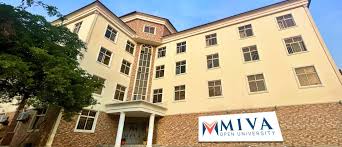… as expert seeks inclusion of private varsities in student loan scheme
The Chancellor of Miva Open University, Sim Shagaya, has reaffirmed the commitment of the university to the delivery of quality education to the students, disclosing that the University now has a total enrollment of over 9,000 students, barely two years into its operation as the first private open university in Nigeria.
The university has also announced an endowment of scholarships to 100 underserved students across Nigeria.
This is just as the Chief Executive Officer (CEO) of Sterling Bank, Abubakar Suleiman, has called on the Federal Government to extend the student loan scheme to private universities.
Suleiman, who was the guest speaker at a colloquium marking the 50th birthday of Sim Shagaya in Abuja, argued that extending the Nigerian Education Loan Fund (NELFUND) loans to students in private universities would further boost access to higher education in Nigeria.
The golden jubilee celebration was intended to mark Shagaya’s legacy of leadership, innovation, and impact under the theme: ‘Legacy of Leadership: Innovating for Impact and Building the Future through Education and Enterprise’.
Shagaya highlighted the university’s rapid growth, saying that its student population had increased from 500 in its first semester in 2023 was the University was established to the current 9000 students, with the project that the enrollment would hit 18,000 by the end of 2025.
Shagaya emphasised that the institution’s true success lies not in numbers but in its impact on society.
“We’re not just building a university; we’re building a civilisation. The ultimate goal is the ascendancy of Nigeria, and Miva is just a vehicle to achieve that,” he said.
The university at the event announced an endowment of scholarships to 100 underserved students across Nigeria.
Meanwhile, Suleiman advocated for an expansion of the student loan scheme to private universities so as to enable Nigerians who are unable to secure admission into public institutions because limited carrying capacity to access education in private tertiary institutions.
He lamented that the education system in Nigeria is in crisis, citing severe infrastructure deficit, shortage of university spaces and academic staff.
“Nigeria faces a crisis. It’s a big one. Even though we now have more private universities than public universities, over 90 per cent of the students are still in government universities.
“Yet, we have less than 2.5 million people in institutions out of a population that is already 230 million.
“There are people who have argued that for you to really become impactful and to industrialise, at least 5 per cent of the population need to be in institutions of higher learning and technical skills,” he said.
Suleiman stressed the need for innovative solutions to address the crisis, suggesting that technology could be leveraged to increase access to quality education while also making it more affordable.
“We can now effectively have access to faculty from beyond Nigeria’s shores, making education more accessible and affordable for millions of people.
“Education needs to be affordable. We’ve been caught in a situation where you either get free education in government universities, which isn’t always effective, or expensive private education, which isn’t accessible to many,” he said.
The Vice-Chancellor of Miva Open University, Prof. Tayo Arulogun, noted that the major problem with tertiary education in Nigeria is skill gaps, attributing this to poor curriculum implementation and monitoring.
He commended the National Universities Commission (NUC) for the introduction of the new Core Curriculum Minimum Academic Standards (CCMAS), explaining that universities now have the opportunity to explore the 30 per cent given to them to bridge the identifiable gaps.
While calling for technology-driven education, Arulogun commended Shagaya’s multifaceted strategy in fostering creative thinking, global partnerships, and technology-driven learning.
He explained that the university’s approach was built on several pillars, including creative thinking, global partnerships, and technology-driven education.
This strategy, he noted, had yielded positive results, with over 4,000 students benefiting from the expertise of professionals.




